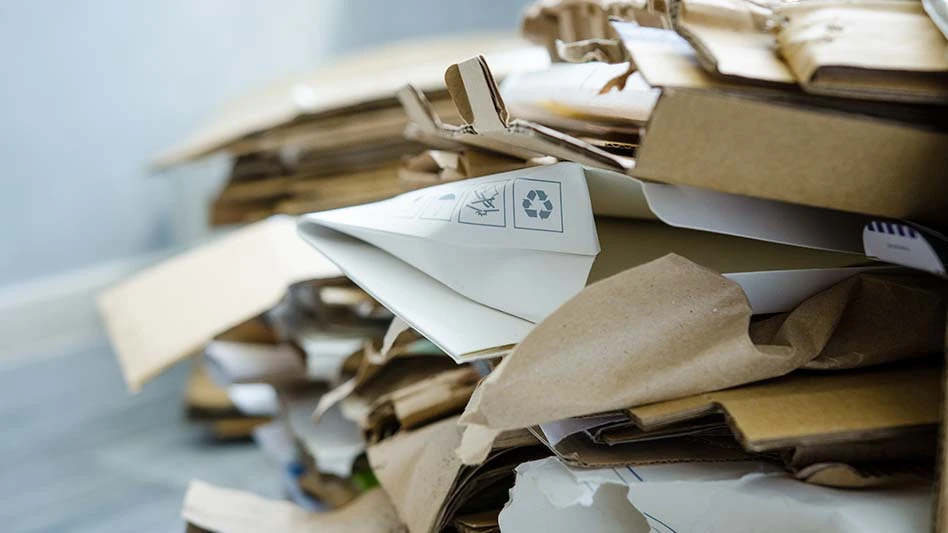Editor’s Note:The following article is an edited transcript from the Paper & Plastics Recycling Conference, which was Oct. 8-11, 2014, in Chicago.
 When I do my plastics recycling reports, I look at it from two standpoints: what is being recycled by region, plus what is happening with the virgin resins themselves.
When I do my plastics recycling reports, I look at it from two standpoints: what is being recycled by region, plus what is happening with the virgin resins themselves.
The first resin I look at is PET (polyethylene terephthalate), which mainly goes into fiber and into bottles. The other resins are the polyethylenes, which are the high-density polyethylenes (HDPEs)—you are familiar with the milk bottles and the detergent bottles and so on—and low- and linear-low-density polyethylenes (L/LLDPE), which go into films and so on; polypropylene (PP), for which there are two major markets—car batteries and carpet backing; polystyrene (PS), which goes into packaging material and into insulation; and polyvinyl chloride (PVC), which goes into nonfood-contact applications and the construction industry.
When I do a report, I look at all those different chemistries, and then I look by region. When I do a region, I look at Canada, the U.S., Mexico, Central and South America (CSA), Western Europe (WE), Central and Eastern Europe (CEE), Africa and the Middle East (AME), Japan, China and then I look at other parts of Asia (ROAsia) as well. I look at recycling rates for all these different chemistries in different regions.
Recycling drivers
A lot of what is going on with plastics recycling is being driven by public policy. You’ve probably seen stuff going on in California and elsewhere with bags and bottles and so on.
There also are corporate initiatives going on, as well as energy conservation and waste-to-energy initiatives. You are going to see a lot more waste to energy; it is further ahead in Europe than it is here in the states. You also have China’s Green Fence initiative and how it’s impacting plastics recycling, as well as developments in shale gas. Shale gas is going to impact on some of these downstream chemistries.
Some of the public policy drivers include marine pollution and litter. You always see advertisements on television regarding how many times you can go around the world with bottles floating in the ocean. Climate change, air emissions and energy conservation also are public policy drives affecting plastics recycling.
The big question related to public policy is who should pay for it. That has a major impact on how plastics are going to be recycled and what percentage is going to be recycled.
Legislative responses to policy drivers are varied and include material bans, which ban the use of certain materials such as PET and PEF (polyethylene furanoate, a biobased alternative to PET). PEF in Europe, if that takes off, PET is going to have a tough time elsewhere in the world as well. There are other resins that are coming out too that could replace PET. I don’t think it is going to happen right away, but there are things out there that could be problematic, let’s put it that way.
Other legislative responses include mandatory recycling and biodegradability laws; bottle deposit bill legislation; expanded collection and stewardship programs; and the implementation of taxes.
There also are laws mandating the use of recycled content in the finished product that is being produced downstream from the recycling operation. Then there are lightweighting and downsizing, which already have had an impact, especially on the PET market. And it is probably going to happen even further.

By the numbers
Some of the numbers you will see here for PET are much higher than what NAPCOR (National Association for PET Container Resources, Sonoma, California) puts out. I add up the virgin resin and the recycled resin to get the actual recycling rate. The number for North America, 19.9 percent, is a much lower number than what you are familiar with, which might be in the 40 to 50 percent range or even higher.
CSA (the Caribbean south, not including Mexico) is the leading region in PET recycling at 39.7 percent. WE is high at 34.1 percent; and Japan is relatively high at 31.2 percent.
CEE, at 20.6 percent; ROAsia, at 20 percent; and even China, at 24.6 percent, are relatively low in comparison, which means for some of those regions, particularly China, there is room for growth, which is good. In one standpoint it means they may not be taking all of the bottles from the United States and North America, impacting the North American market.
For a table that outlines the percentage of virgin and recycled resins combined that are recycled by world region, see below.
As you can see, HDPE recycling in CSA, again, is very high; they have done an excellent job. Trying to get data from there is very difficult because some of that is Dumpster diving, and even some of the universities down there have a hard time getting the data on how much is actually being recycled.
You can see by chemistry how much is being consumed from a recycled standpoint. It shows you that there is still a lot of growth potential for recycled resins.
Some of the key information that jumps out is that Japan recycles 12.3 percent of its PVC. And the EPS (expandable polystyrene) recycling rates in CSA and Japan are very high numbers, much higher than other parts of the world. PP recycling is very high in other parts of Asia.
The volumes of plastic resins recycled globally in 2013 in thousands of metric tons are:
- PP, 2,505;
- PET, 5,310;
- HDPE, 3,631;
- L/LLDPE, 4,631;
- EPS, 395; and
- PVC, 3,063.
Consuming markets
Markets for virgin resins and recycled resins are not always the same; they can be the same, but they are not always the same. Virgin resins go into a lot of different things than recycled resins do. In a lot of cases, the market for recycled resins probably has a lot more opportunity to expand.
One of the things that is important, too, is that more people are requiring more plastics. I think that is the key thing that you want to come away with. In the future there are going to be much more plastics in the marketplace. The amount of plastics per capita is going to be increasing globally, and part of that is because of growth in GDP (gross domestic product) and the amount of disposable income in some of these developing countries. As those increase, more plastics are going to be consumed. Plastics are going to grow at a pretty good, steady rate.
In particular, there is a lot of lightweighting going on in the automotive industry, and many auto manufacturers are using a lot more plastics to get vehicle weight down because they have to meet legislative guidelines for miles per gallon. The only way to do that other than technologically with the motors and carburetors on the vehicles is to make the cars lighter.
Shale gas will have a positive impact on ethylene and PP production costs but will have a negative impact on PS and EPS production, which is not a big market anyway. I don’t see it making a big impact on PETs and HDPEs, at least in the short term. Where it is going to have the impact is PS.
Recycled plastics do have a niche in the marketplace, and that is going to remain. I think with people being more creative with the things they can make out of recycled plastics, their end use is limitless.
Recycled plastics collection, reclamation and consumption will continue to grow.
Jim Glauser is associate director of IHS Chemical, Englewood, Colorado, and can be reached at jim.glauser@ihs.com.

Explore the January 2015 Issue
Check out more from this issue and find your next story to read.
Latest from Recycling Today
- Hyundai says it will make steel in the US
- APR announces Recycling Leadership Award winners
- Glass Half Full opens glass recycling facility in Louisiana
- AmpUp partners with Roundtrip EV
- Global Recycling Day event supports Pittsburgh school's recycling efforts
- President signs executive order on critical minerals
- Registration opens for Scrap Expo 2025
- Toyota opens ‘circular factory’ in UK





